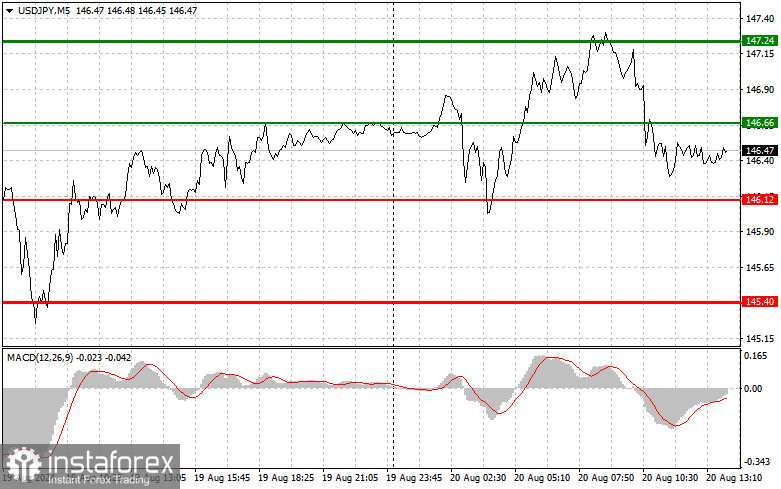Analysis of Trades and Advice on Trading the Japanese Yen
The test of the 146.74 level occurred when the MACD indicator was just beginning its downward movement from the zero line, confirming a correct entry point for selling the dollar as part of the ongoing downtrend. As a result, the pair dropped by about 50 points. However, we didn't quite reach the target level of 145.78. In the second half of the day, we expect speeches from FOMC members Raphael Bostic, known for his dovish monetary policy stance, and Michael S. Barr, who is recognized for a more conservative approach to rate changes. Given the weakness of the U.S. dollar, any statements regarding a more aggressive rate cut could prompt traders to sell the dollar and buy the yen. As for the intraday strategy, I plan to act based on the implementation of Scenarios 1 and 2.

Buy Signal
Scenario 1: Today, I plan to buy USD/JPY if it reaches around 146.66 (green line on the chart), with a target of rising to 147.24 (thicker green line on the chart). Around 147.24, I will exit the purchase and open a sell position, expecting a movement of 30-35 points from the level. The pair's growth today is likely only if sellers refrain from acting aggressively following the speeches by U.S. policymakers. It's important to ensure that the MACD indicator is above the zero line and just beginning its upward movement before buying.
Scenario 2: I also plan to buy USD/JPY today if there are two consecutive tests of the 146.12 price level when the MACD indicator is in the oversold zone. This will limit the pair's downward potential and likely cause an upward reversal. Growth can be expected toward the resistance levels of 146.66 and 147.24.
Sell Signal
Scenario 1: Today, I plan to sell USD/JPY after it breaks below the 146.12 level (red line on the chart), which will lead to a rapid decline in the pair. The key target for sellers will be the 145.40 level, where I will exit the sell position and immediately open a buy position, expecting a movement of 20-25 points from the level. Selling pressure on the pair will return if FOMC representatives adopt a dovish stance. It's important to ensure that the MACD indicator is below the zero line and just beginning its downward movement before selling.
Scenario 2: I also plan to sell USD/JPY today if there are two consecutive tests of the 146.66 price level when the MACD indicator is in the overbought zone. This will limit the pair's upward potential and likely cause a downward reversal. A decline can be expected toward the support levels of 146.12 and 145.40.

Chart Overview:
- Thin green line: Entry price to buy the trading instrument;
- Thick green line: Expected price level where you can set Take Profit or manually lock in profits, as further growth above this level is unlikely;
- Thin red line: Entry price to sell the trading instrument;
- Thick red line: Expected price level where you can set Take Profit or manually lock in profits, as further decline below this level is unlikely;
- MACD Indicator: When entering the market, it's important to be guided by overbought and oversold zones.
Important: Beginner traders in the Forex market should be very cautious when making decisions about entering the market. Before the release of significant fundamental reports, it's best to stay out of the market to avoid sharp price fluctuations. If you choose to trade during news releases, always set stop orders to minimize losses. Without setting stop orders, you can quickly lose your entire deposit, especially if you don't use money management and trade with large volumes.
And remember, to trade successfully, you need a clear trading plan, like the one I've outlined above. Making spontaneous trading decisions based on the current market situation is initially a losing strategy for an intraday trader.
 English
English 
 Русский
Русский Bahasa Indonesia
Bahasa Indonesia Bahasa Malay
Bahasa Malay ไทย
ไทย Español
Español Deutsch
Deutsch Български
Български Français
Français Tiếng Việt
Tiếng Việt 中文
中文 বাংলা
বাংলা हिन्दी
हिन्दी Čeština
Čeština Українська
Українська Română
Română

